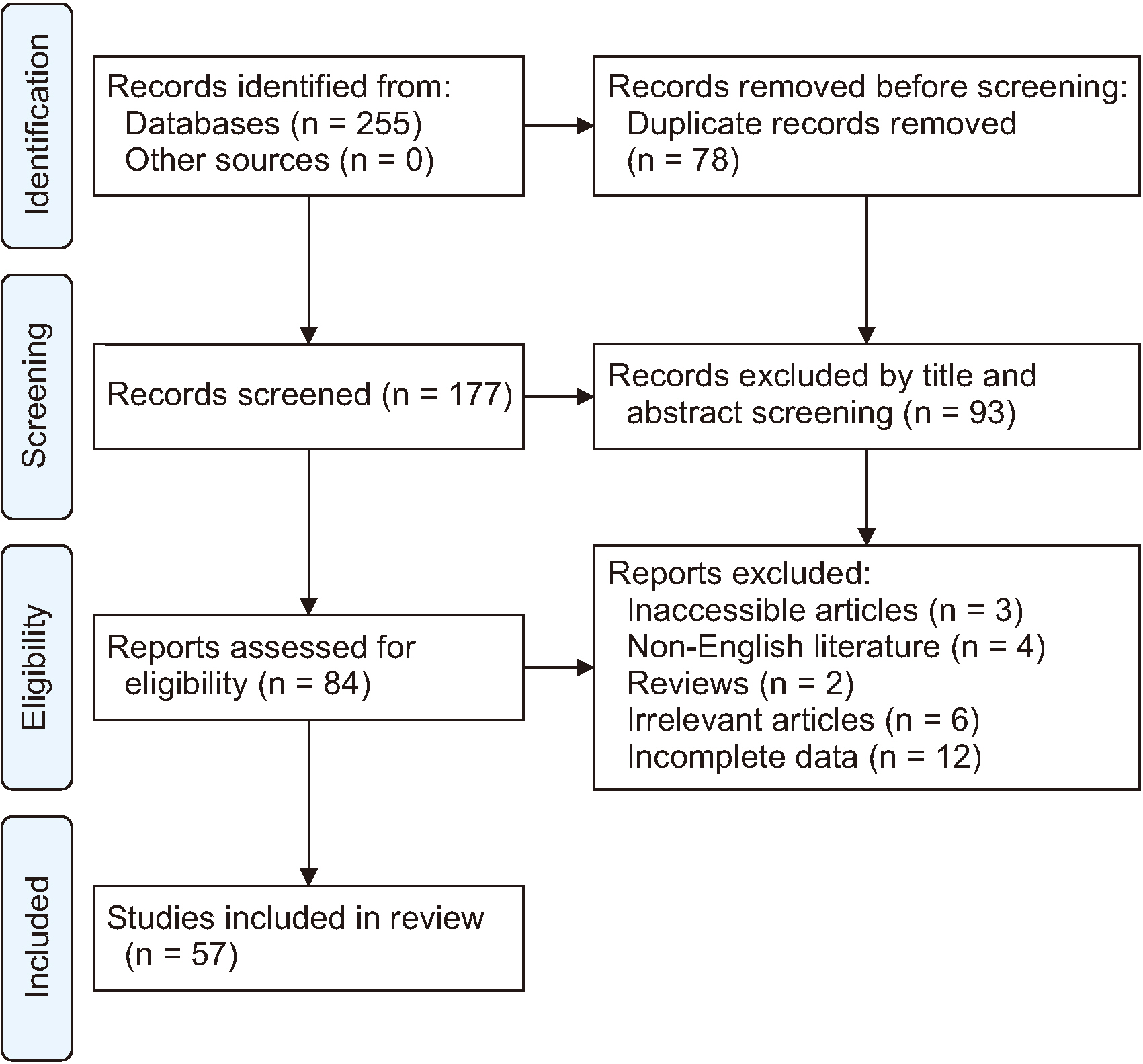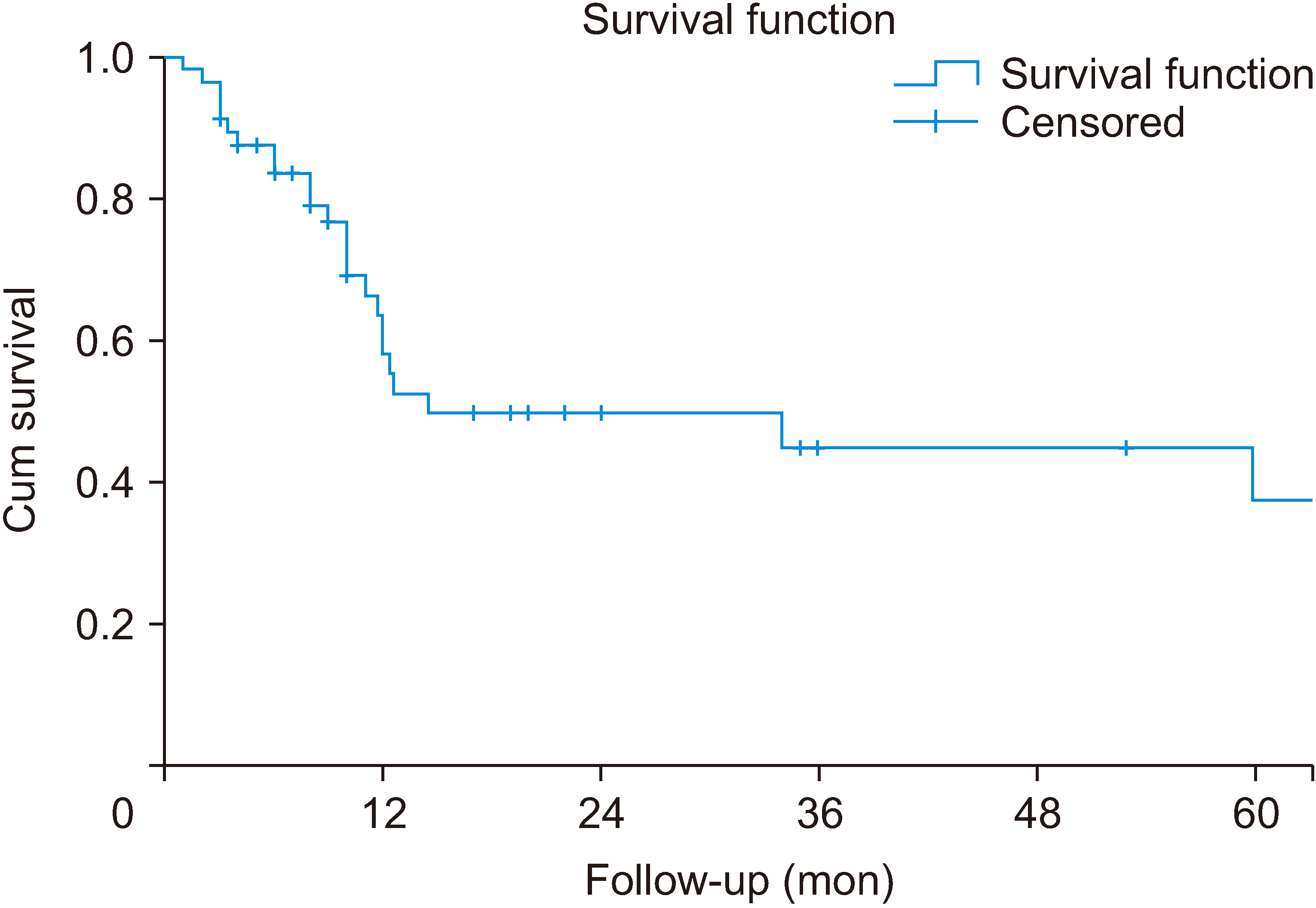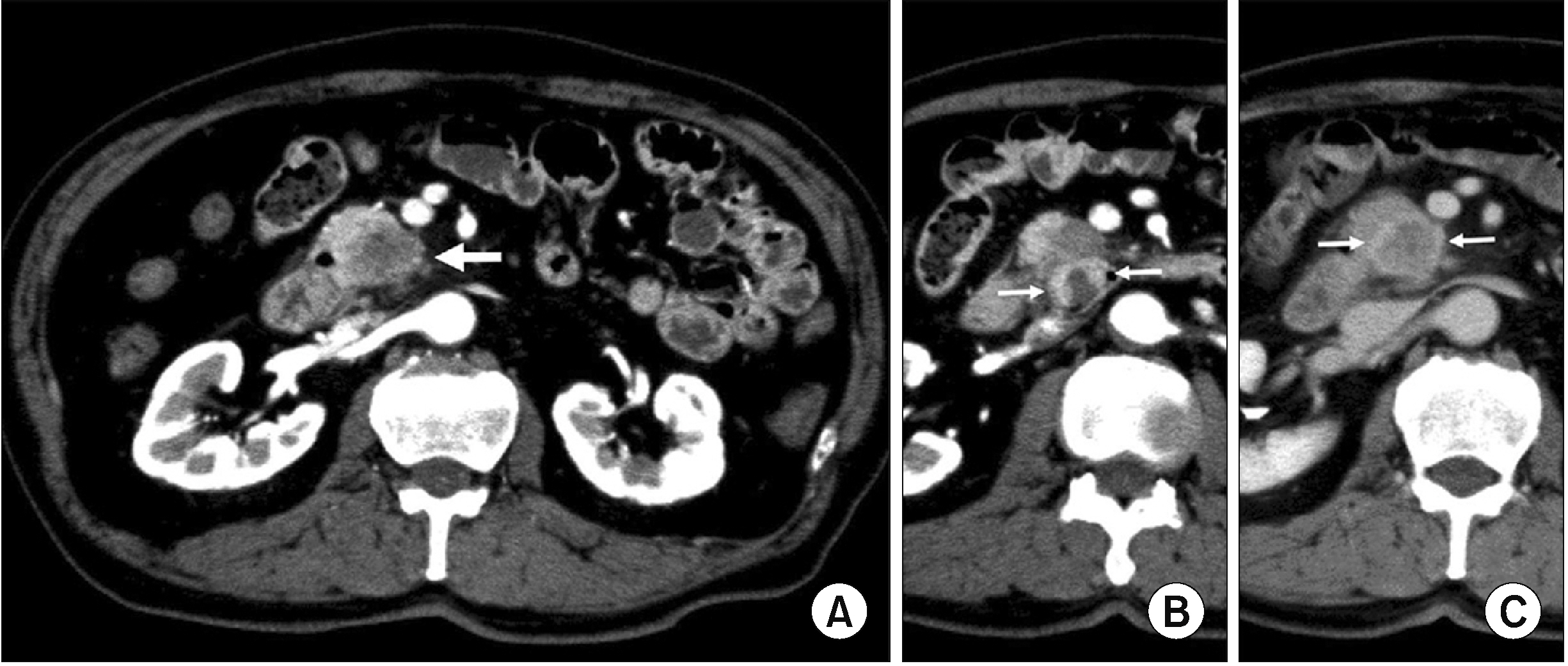Ann Hepatobiliary Pancreat Surg.
2024 May;28(2):125-133. 10.14701/ahbps.23-161.
Undifferentiated carcinoma with osteoclast-like giant cells of the pancreas: An individual participant data meta-analysis
- Affiliations
-
- 1First Department of Surgery, National and Kapodistrian University of Athens, Laikon General Hospital, Athens, Greece
- 2First Department of Pathology, National and Kapodistrian University of Athens, Medical School, Athens, Greece
- 3Third Department of Surgery, National and Kapodistrian University of Athens, Attikon University Hospital, Athens, Greece
- 4First Propaedeutic Department of Surgery, National and Kapodistrian University of Athens, Hippokration General Hospital, Athens, Greece
- 5Second Department of Propaedeutic Surgery, National and Kapodistrian University of Athens, Laikon General Hospital, Athens, Greece
- 6Department of Surgery, General Hospital of Ierapetra, Ierapetra, Greece
- KMID: 2555925
- DOI: http://doi.org/10.14701/ahbps.23-161
Abstract
- Undifferentiated carcinoma with osteoclast-like giant cells (UC−OGCs) of the pancreas is a rare neoplasm that accounts for less than 1% of all pancreatic malignancies. The aim of this study was to review the literature regarding UC−OGC, and to highlight its biological behavior, clinicopathologic characteristics, prognosis, and therapeutic options. A systematic review of the literature in PubMed/ Medline and Scopus databases was performed (last search October 31st, 2023) for articles concerning pancreatic UC−OGC in the adult population. Fifty-seven studies met the inclusion criteria, involving 69 patients with a male-to-female ratio of 1.1:1 and a mean age of 62.96. Main symptoms included abdominal pain (33.3%), jaundice (14.5%), weight loss (8.7%), while fourteen patients (20.3%) were asymptomatic. Surgical resection was performed in 88.4% of cases. Survival rates at one, three, and five years were 58%, 44.7%, and 37.3% respectively. Sex, age, size (cut-off of 4 cm), location, and adjuvant treatment did not significantly affect patient survival. UC− OGC of the pancreas is a rare subtype of undifferentiated pancreatic carcinoma with a better prognosis than conventional pancreatic ductal adenocarcinoma or undifferentiated carcinoma without giant cells. The establishment of a dedicated patient registry is imperative to further delineate the optimal treatment for this uncommon clinical entity.
Figure
Reference
-
References
1. Nagtegaal ID, Odze RD, Klimstra D, Paradis V, Rugge M, Schirmacher P, et al. 2020; The 2019 WHO classification of tumours of the digestive system. Histopathology. 76:1821188. DOI: 10.1111/his.13975. PMID: 31433515. PMCID: PMC7003895.
Article2. Demetter P, Maréchal R, Puleo F, Delhaye M, Debroux S, Charara F, et al. 2021; Undifferentiated pancreatic carcinoma with osteoclast-like giant cells: what do we know so far? Front Oncol. 11:630086. DOI: 10.3389/fonc.2021.630086. PMID: 33747949. PMCID: PMC7973287.
Article3. Maksymov V, Khalifa MA, Bussey A, Carter B, Hogan M. 2011; Undifferentiated (anaplastic) carcinoma of the pancreas with osteoclast-like giant cells showing various degree of pancreas duct involvement. A case report and literature review. JOP. 12:170–176.4. Gao HQ, Yang YM, Zhuang Y, Liu P. 2015; Locally advanced undifferentiated carcinoma with osteoclast-like giant cells of the pancreas. World J Gastroenterol. 21:694–698. DOI: 10.3748/wjg.v21.i2.694. PMID: 25593500. PMCID: PMC4292306.
Article5. Loya AC, Ratnakar KS, Shastry RA. 2004; Combined osteoclastic giant cell and pleomorphic giant cell tumor of the pancreas: a rarity. An immunohistochemical analysis and review of the literature. JOP. 5:220–224.6. Ashfaq A, Thalambedu N, Atiq MU. 2022; A rare case of pancreatic cancer: undifferentiated carcinoma of the pancreas with osteoclast-like giant cells. Cureus. 14:e25118. DOI: 10.7759/cureus.25118.
Article7. Guo YL, Ruan LT, Wang QP, Lian J. 2018; Undifferentiated carcinoma with osteoclast-like giant cells of pancreas: a case report with review of the computed tomography findings. Medicine (Baltimore). 97:e13516. DOI: 10.1097/MD.0000000000013516. PMID: 30508980. PMCID: PMC6283196.8. Zou XP, Yu ZL, Li ZS, Zhou GZ. 2004; Clinicopathological features of giant cell carcinoma of the pancreas. Hepatobiliary Pancreat Dis Int. 3:300–302.9. Lukás Z, Dvorák K, Kroupová I, Valásková I, Habanec B. 2006; Immunohistochemical and genetic analysis of osteoclastic giant cell tumor of the pancreas. Pancreas. 32:325–329. DOI: 10.1097/01.mpa.0000202951.10612.fa. PMID: 16628090.
Article10. Paal E, Thompson LD, Frommelt RA, Przygodzki RM, Heffess CS. 2001; A clinicopathologic and immunohistochemical study of 35 anaplastic carcinomas of the pancreas with a review of the literature. Ann Diagn Pathol. 5:129–140. DOI: 10.1053/adpa.2001.25404. PMID: 11436166.
Article11. Bergmann F, Esposito I, Michalski CW, Herpel E, Friess H, Schirmacher P. 2007; Early undifferentiated pancreatic carcinoma with osteoclastlike giant cells: direct evidence for ductal evolution. Am J Surg Pathol. 31:1919–1925. DOI: 10.1097/PAS.0b013e318067bca8. PMID: 18043049.
Article12. Wada T, Itano O, Oshima G, Chiba N, Ishikawa H, Koyama Y, et al. 2011; A male case of an undifferentiated carcinoma with osteoclast-like giant cells originating in an indeterminate mucin-producing cystic neoplasm of the pancreas. A case report and review of the literature. World J Surg Oncol. 9:100. DOI: 10.1186/1477-7819-9-100. PMID: 21902830. PMCID: PMC3186749.
Article13. Hirano H, Morita K, Tachibana S, Okimura A, Fujisawa T, Ouchi S, et al. 2008; Undifferentiated carcinoma with osteoclast-like giant cells arising in a mucinous cystic neoplasm of the pancreas. Pathol Int. 58:383–389. DOI: 10.1111/j.1440-1827.2008.02240.x. PMID: 18477218.
Article14. Muraki T, Reid MD, Basturk O, Jang KT, Bedolla G, Bagci P, et al. 2016; Undifferentiated carcinoma with osteoclastic giant cells of the pancreas: clinicopathologic analysis of 38 cases highlights a more protracted clinical course than currently appreciated. Am J Surg Pathol. 40:1203–1216. DOI: 10.1097/PAS.0000000000000689. PMID: 27508975. PMCID: PMC4987218.
Article15. Page MJ, McKenzie JE, Bossuyt PM, Boutron I, Hoffmann TC, Mulrow CD, et al. 2021; The PRISMA 2020 statement: an updated guideline for reporting systematic reviews. BMJ. 372:n71. DOI: 10.1136/bmj.n71. PMID: 33782057. PMCID: PMC8005924.16. Yazawa T, Watanabe A, Araki K, Segawa A, Hirai K, Kubo N, et al. 2017; Complete resection of a huge pancreatic undifferentiated carcinoma with osteoclast-like giant cells. Int Cancer Conf J. 6:193–196. DOI: 10.1007/s13691-017-0305-y. PMID: 31149501. PMCID: PMC6498254.
Article17. Olayinka O, Kaur G, Gupta G. 2021; Undifferentiated pancreatic carcinoma with osteoclast-like giant cells and associated ductal adenocarcinoma with focal signet-ring features. Cureus. 13:e14988. DOI: 10.7759/cureus.14988.
Article18. Hur YH, Kim HH, Seoung JS, Seo KW, Kim JW, Jeong YY, et al. 2011; Undifferentiated carcinoma of the pancreas with osteoclast-like giant cells. J Korean Surg Soc. 81:146–150. DOI: 10.4174/jkss.2011.81.2.146. PMID: 22066115. PMCID: PMC3204565.
Article19. Vnuk K, Pavić I, Brletić D, Zovak M, Krušlin B. 2022; Undifferentiated carcinoma of the pancreas with osteoclast-like giant cells: report of two cases. Lib Oncol. 50:39–43. DOI: 10.20471/LO.2022.50.01.07.
Article20. Matsubayashi H, Kaneko J, Sato J, Satoh T, Ishiwatari H, Sugiura T, et al. 2019; Osteoclast-like giant cell-type pancreatic anaplastic carcinoma presenting with a duodenal polypoid lesion. Intern Med. 58:3545–3550. DOI: 10.2169/internalmedicine.3271-19. PMID: 31462592. PMCID: PMC6949449.
Article21. Osaka H, Yashiro M, Nishino H, Nakata B, Ohira M, Hirakawa K. 2004; A case of osteoclast-type giant cell tumor of the pancreas with high-frequency microsatellite instability. Pancreas. 29:239–241. DOI: 10.1097/00006676-200410000-00010. PMID: 15367891.
Article22. Igarashi Y, Gocho T, Taniai T, Uwagawa T, Hamura R, Shirai Y, et al. 2022; Conversion surgery for undifferentiated carcinoma with osteoclast-like giant cells of the pancreas: a case report. Surg Case Rep. 8:42. DOI: 10.1186/s40792-022-01385-x. PMID: 35286506. PMCID: PMC8921425.
Article23. Kharkhach A, Bouhout T, Serji B, El Harroudi T. 2021; Undifferentiated pancreatic carcinoma with osteoclast-like giant cells: a review and case report analysis. J Gastrointest Cancer. 52:1106–1113. DOI: 10.1007/s12029-021-00583-4. PMID: 33447945.
Article24. Lahiff C, Swan N, Conlon K, Malone D, Maguire D, Hoti E, et al. 2016; Osteoclastic-type giant cell tumours of the pancreas: a homogenous series of rare tumours diagnosed by endoscopic ultrasound. Dig Surg. 33:401–405. DOI: 10.1159/000445303. PMID: 27160213.
Article25. Obayashi M, Shibasaki Y, Koakutsu T, Hayashi Y, Shoji T, Hirayama K, et al. 2020; Pancreatic undifferentiated carcinoma with osteoclast-like giant cells curatively resected after pembrolizumab therapy for lung metastases: a case report. BMC Gastroenterol. 20:220. DOI: 10.1186/s12876-020-01362-4. PMID: 32652936. PMCID: PMC7353752.
Article26. Speisky D, Villarroel M, Vigovich F, Iotti A, García TA, Quero LB, et al. 2020; Undifferentiated carcinoma with osteoclast-like giant cells of the pancreas diagnosed by endoscopic ultrasound guided biopsy. Ecancermedicalscience. 14:1072. DOI: 10.3332/ecancer.2020.1072. PMID: 32863866. PMCID: PMC7434513.27. Swaid MB, Vitale E, Alatassi N, Siddiqui H, Yazdani H. 2022; Metastatic undifferentiated osteoclast-like giant cell pancreatic carcinoma. Cureus. 14:e27586. DOI: 10.7759/cureus.27586.
Article28. Pop RM, Diaconu CI, Rimbaş M, Mateescu RB, Rouhani F, Popp C, et al. 2023; EUS-guided fine needle biopsy is able to provide diagnosis in rare osteoclast-like giant cells undifferentiated carcinoma of the pancreas: report of two cases. Rom J Intern Med. 61:116–124. DOI: 10.2478/rjim-2023-0008. PMID: 36884386.
Article29. Molberg KH, Heffess C, Delgado R, Albores-Saavedra J. 1998; Undifferentiated carcinoma with osteoclast-like giant cells of the pancreas and periampullary region. Cancer. 82:1279–1287. DOI: 10.1002/(SICI)1097-0142(19980401)82:7<1279::AID-CNCR10>3.0.CO;2-3.
Article30. Amin MB, Greene FL, Edge SB, Compton CC, Gershenwald JE, Brookland RK, et al. 2017; The Eighth Edition AJCC Cancer Staging Manual: continuing to build a bridge from a population-based to a more 'personalized' approach to cancer staging. CA Cancer J Clin. 67:93–99. DOI: 10.3322/caac.21388. PMID: 28094848.
Article31. Mattiolo P, Fiadone G, Paolino G, Chatterjee D, Bernasconi R, Piccoli P, et al. 2021; Epithelial-mesenchymal transition in undifferentiated carcinoma of the pancreas with and without osteoclast-like giant cells. Virchows Arch. 478:319–326. DOI: 10.1007/s00428-020-02889-3. PMID: 32661742. PMCID: PMC7969490.
Article32. Maier HC, Sommers SC. 1987; Recurrent and metastatic pulmonary fibrous histiocytoma/plasma cell granuloma in a child. Cancer. 60:1073–1076. DOI: 10.1002/1097-0142(19870901)60:5<1073::AID-CNCR2820600524>3.0.CO;2-O. PMID: 3038296.
Article33. Jo S. 2014; Huge undifferentiated carcinoma of the pancreas with osteoclast-like giant cells. World J Gastroenterol. 20:2725–2730. DOI: 10.3748/wjg.v20.i10.2725. PMID: 24627610. PMCID: PMC3949283.
Article34. Sakhi R, Hamza A, Khurram MS, Ibrar W, Mazzara P. 2017; Undifferentiated carcinoma of the pancreas with osteoclast-like giant cells reported in an asymptomatic patient: a rare case and literature review. Autops Case Rep. 7:51–57. DOI: 10.4322/acr.2017.042. PMID: 29259932. PMCID: PMC5724056.
Article35. Luchini C, Pea A, Lionheart G, Mafficini A, Nottegar A, Veronese N, et al. 2017; Pancreatic undifferentiated carcinoma with osteoclast-like giant cells is genetically similar to, but clinically distinct from, conventional ductal adenocarcinoma. J Pathol. 243:148–154. DOI: 10.1002/path.4941. PMID: 28722124. PMCID: PMC6664430.
Article36. Matissek SJ, Elsawa SF. 2020; GLI3: a mediator of genetic diseases, development and cancer. Cell Commun Signal. 18:54. DOI: 10.1186/s12964-020-00540-x. PMID: 32245491. PMCID: PMC7119169.
Article37. Yonemasu H, Takashima M, Nishiyama KI, Ueki T, Yao T, Tanaka M, et al. 2001; Phenotypical characteristics of undifferentiated carcinoma of the pancreas: a comparison with pancreatic ductal adenocarcinoma and relevance of E-cadherin, alpha catenin and beta catenin expression. Oncol Rep. 8:745–752. DOI: 10.3892/or.8.4.745. PMID: 11410776.38. Sano M, Homma T, Hayashi E, Noda H, Amano Y, Tsujimura R, et al. 2014; Clinicopathological characteristics of anaplastic carcinoma of the pancreas with rhabdoid features. Virchows Arch. 465:531–538. DOI: 10.1007/s00428-014-1631-5. PMID: 25031015.
Article39. Naito Y, Kinoshita H, Okabe Y, Arikawa S, Higaki K, Morimitsu Y, et al. 2009; Pathomorphologic study of undifferentiated carcinoma in seven cases: relationship between tumor and pancreatic duct epithelium. J Hepatobiliary Pancreat Surg. 16:478–484. DOI: 10.1007/s00534-009-0078-6. PMID: 19367361.
Article40. Kubota N, Naito Y, Kawahara A, Taira T, Yamaguchi T, Yoshida T, et al. 2017; Granulocyte colony-stimulating factor-producing pancreatic anaplastic carcinoma in ascitic fluid at initial diagnosis: a case report. Diagn Cytopathol. 45:463–467. DOI: 10.1002/dc.23682. PMID: 28185423.
Article41. Togawa Y, Tonouchi A, Chiku T, Sano W, Doki T, Yano K, et al. 2010; A case report of undifferentiated carcinoma with osteoclast-like giant cells of the pancreas and literature review. Clin J Gastroenterol. 3:195–203. DOI: 10.1007/s12328-010-0160-2. PMID: 26190247.
Article42. Fukukura Y, Kumagae Y, Hirahara M, Hakamada H, Nagano H, Nakajo M, et al. 2019; CT and MRI features of undifferentiated carcinomas with osteoclast-like giant cells of the pancreas: a case series. Abdom Radiol (NY). 44:1246–1255. DOI: 10.1007/s00261-019-01958-9. PMID: 30815714.
Article43. Shindoh N, Ozaki Y, Kyogoku S, Nakanishi A, Sumi Y, Katayama H. 1998; Osteoclast-type giant cell tumor of the pancreas: helical CT scans. AJR Am J Roentgenol. 170:653–654. DOI: 10.2214/ajr.170.3.9490947. PMID: 9490947.
Article44. Yang KY, Choi JI, Choi MH, Park MY, Rha SE, Byun JY, et al. 2015; Magnetic resonance imaging findings of undifferentiated carcinoma with osteoclast-like giant cells of pancreas. Clinical Imaging. 40:148–151. DOI: 10.1016/j.clinimag.2015.09.013. PMID: 26520702.
Article45. Brosens LA, Leguit RJ, Vleggaar FP, Veldhuis WB, van Leeuwen MS, Offerhaus GJA. 2015; EUS-guided FNA cytology diagnosis of paraduodenal pancreatitis (groove pancreatitis) with numerous giant cells: conservative management allowed by cytological and radiological correlation. Cytopathology. 26:122125. DOI: 10.1111/cyt.12140. PMID: 24650015.
Article46. Luchini C. 2021; Undifferentiated carcinoma of the pancreas with osteoclast-like giant cells: a challenging cancer with new horizons? Virchows Archiv. 478:595–596. DOI: 10.1007/s00428-021-03021-9. PMID: 33447898.
Article47. Manduch M, Dexter DF, Jalink DW, Vanner SJ, Hurlbut DJ. 2009; Undifferentiated pancreatic carcinoma with osteoclast-like giant cells: report of a case with osteochondroid differentiation. Pathol Res Pract. 205:353–359. DOI: 10.1016/j.prp.2008.11.006. PMID: 19147301.
Article48. Oymaci E, Yakan S, Yildirim M, Argon A, Namdaroglu O. 2017; Anaplastic carcinoma of the pancreas: a rare clinical entity. Cureus. 9:e1782. DOI: 10.7759/cureus.1782. PMID: 29279808. PMCID: PMC5736168.
Article49. Ren B, Liu X, Suriawinata AA. 2019; Pancreatic ductal adenocarcinoma and its precursor lesions: histopathology, cytopathology, and molecular pathology. Am J Pathol. 189:9–21. DOI: 10.1016/j.ajpath.2018.10.004. PMID: 30558727.50. Jang KT, Park SM, Basturk O, Bagci P, Bandyopadhyay S, Stelow EB, et al. 2015; Clinicopathologic characteristics of 29 invasive carcinomas arising in 178 pancreatic mucinous cystic neoplasms with ovarian-type stroma: implications for management and prognosis. Am J Surg Pathol. 39:179–187. DOI: 10.1097/PAS.0000000000000357. PMID: 25517958. PMCID: PMC4460193.
Article51. Shiozawa M, Imada T, Ishiwa N, Rino Y, Hasuo K, Takanashi Y, et al. 2002; Osteoclast-like giant cell tumor of the pancreas. Int J Clin Oncol. 7:376–380. DOI: 10.1007/s101470200059. PMID: 12494256.
Article52. Strobel O, Hartwig W, Bergmann F, Hinz U, Hackert T, Grenacher L, et al. 2011; Anaplastic pancreatic cancer: presentation, surgical management, and outcome. Surgery. 149:200–208. DOI: 10.1016/j.surg.2010.04.026. PMID: 20542529.
Article53. Xu M, Chen W, Wang D, Nie M. 2020; Clinical characteristics and prognosis of osteoclast-like giant cell tumors of the pancreas compared with pancreatic adenocarcinomas: a population-based study. Med Sci Monit. 26:e922585. DOI: 10.12659/MSM.922585.
Article54. Hrudka J, Lawrie K, Waldauf P, Ciprová V, Moravcová J, Matěj R. 2020; Negative prognostic impact of PD-L1 expression in tumor cells of undifferentiated (anaplastic) carcinoma with osteoclast-like giant cells of the pancreas: study of 13 cases comparing ductal pancreatic carcinoma and review of the literature. Virchows Arch. 477:687–696. DOI: 10.1007/s00428-020-02830-8. PMID: 32424767.
Article
- Full Text Links
- Actions
-
Cited
- CITED
-
- Close
- Share
- Similar articles
-
- A Case of Undifferentiated Carcinoma with Osteoclast-Like Giant Cells in the Pancreas
- Undifferentiated Carcinoma with Osteoclast-Like Giant Cells of the Pancreas Mimicking a Predominantly Calcified Mass: Case Report and Literature Review
- A case of undifferentiated carcinoma with osteoclast-like giant cells of the pancreas
- Undifferentiated carcinoma of the pancreas with osteoclast-like giant cells
- Undifferentiated Gallbladder Carcinoma with Osteoclast-like Giant Cells: A Case Report






